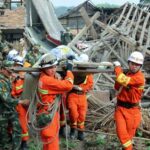The Office for the Coordination of Humanitarian Affairs (OCHA) in collaboration with the Inter-Agency Standing Committee (IASC) is the arm of the United Nations responsible for bringing together national and international humanitarian providers to ensure a coherent response to emergencies. OCHA also ensures that a framework is in place within which each provider can contribute to the overall response effort. It also advocates for people in need, promotes preparedness and prevention and facilitates sustainable solutions.
The Food and Agriculture Organisation of the UN (FAO) provides early warning of impending food crises, and assesses global food supply problems.
The International Organisation for Migration (IOM) is an intergovernmental agency which helps transfer refugees, internally displaced persons and others in need of internal or international migration services.
The Office of United Nations High Commissioner for Human Rights (OHCHR) provides assistance and advice to governments and other actors on human rights issues, sets standards and monitors rights violations.
The United Nations Development Programme (UNDP) assists disaster-prone countries in contingency planning and with disaster mitigation, prevention and preparedness measures.
The United Nations High Commission for Refugees (UNHCR) provides international protection and assistance for refugees, stateless persons and internally displaced persons, particularly in conflict-related emergencies.
The United Nations Children’s Emergency Fund (UNICEF) works to uphold children’s rights, survival, development and protection by intervening in health, education, water, sanitation, hygiene and protection.
The World Food Programme (WFP) is the principle supplier of relief food aid.
The World Health Organization (WHO) provides global public health leadership by setting standards, monitoring health trends, and providing direction on emergency health issues. WHO’s role is to reduce avoidable loss of life and the burden of disease and disability. A range of technical guidelines for health action in crises and pre-deployment training courses are available. A set of technical hazard sheets on earthquakes, drought, floods and landslides, is also available.


